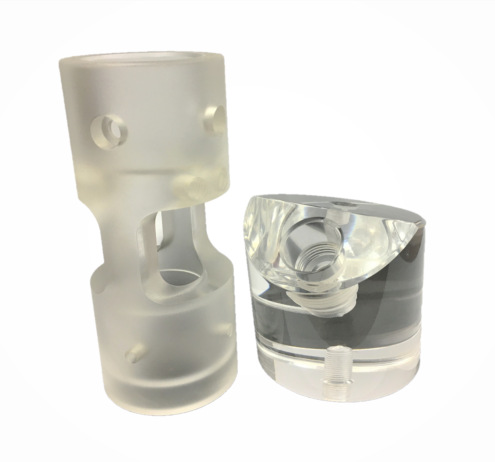Acrylic Cast

Acrylic Cast Overview
What is the Material: Acrylic Cast is an amorphous material.
Key Material Features: This material is beneficial in applications requiring transparency, strength, dimensional stability, and weather resistance.
Other Considerations: It is also available as an extruded material, which is lower cost, but lesser quality than cast acrylic material in both optical and physical properties.
Physical
| Property | Value | Typical ASTM Test |
|---|---|---|
| Chemical Designation | (PMMA) Polymethyl methacrylate | |
| Trade Names (®, ™) | Plexiglas, Optix | |
| Color | Clear, Colored Options | |
| Density (g/cm^3) | 1.19 | D 792 |
Mechanical
| Property | Value | Typical ASTM Test |
|---|---|---|
| Modulus of Elasticity (Tensile Test) (psi) | 400000 | D 638 |
| Tensile Strength at Yield (psi) | 10500 | D 638 |
| Tensile Strength at Break (psi) | 10500 | D 638 |
| Elongation at Break (%) | 4.9 | D 638 |
| Flexural Strength (psi) | 16000 | D 790 |
| Modulus of Elasticity (Flexural Test) (psi) | 450000 | D 790 |
| Compression Strength: 10% Strain (psi) | 14000 | D 695 |
| Impact Strength (Izod) (ft-lbs/in) | 0.3 | D 256 |
| Hardness (M) | 100 | D 785 |
Thermal
| Property | Value | Typical ASTM Test |
|---|---|---|
| Melting Point (°F) | 300 | D 3418 |
| Deflection Temperature (°F) (66 psi) | 207 | D 648 |
| Deflection Temperature (°F) (264 psi) | 205 | D 648 |
| Service Temperature Continuous (°F) | 190 | |
| Thermal Expansion (CLTE) (in/in/°F) | 3.90E-5 | D 696 |
| Thermal Conductivity (BTU-in/hr-ft^2-°F) | 1.3 | |
| Specific Heat (BTU/lb-°F) | 0.35 |
Electrical
| Property | Value | Typical ASTM Test |
|---|---|---|
| Dielectric Strength (V/mil) | 400 | D 149 |
| Dissipation Factor (60 Hz) | 0.06 | D 150 |
| Dielectric Constant (60 Hz and 50% RH) | 3.6 | D 150 |
Other
| Property | Value | Typical ASTM Test |
|---|---|---|
| Moisture Absorption (%) (24 Hours) | 0.2 | D 570 |
| Moisture Absorption (%) (Saturated) | 0.8 | D 570 |
| Light Transmission (%) | 92 | D1008 |
| Flammability | HB |
The data stated are typical values intended for reference and comparison purposes only. The data should not be used as a basis for design specifications or quality control. The information is provided as a guide to the best of our knowledge and given without obligation or liability. Testing under individual application circumstances is recommended.
